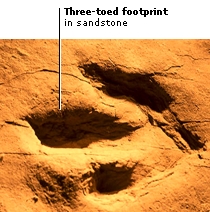DK Science: Trace Fossils
Some of the most interesting fossils contain nothing of the dinosaur itself. They are simply the marks the animal left behind as it walked along and take the form of footprints, skin impressions, or even its droppings. Fossils like this are called trace fossils and can be very useful as they give scientists an insight into how the dinosaur lived. Nests and eggs also provide useful indications of a dinosaur’s lifestyle. It is usually easier to identify a particular dinosaur from a nest or a fossilized egg than from a trace fossil.
Finding an impression of dinosaur skin is rare but very exciting for the palaeontologist. A trace fossil of skin may happen when a dinosaur has lain or sat down in a muddy hollow. The mud, along with the impression, is later buried and turned to stone. More often, skin survives as a fossil when a dinosaur has been buried shortly after death, skin intact. The skin decays away, but the surrounding mud has already taken an impression.
The most common type of trace fossils is footprints. Fossil tracks are sometimes more common than the animal’s body fossils. A dinosaur will leave only one dead body, but perhaps millions of footprints. They show how the animal walked, whether it lived alone or with others, and even whether or not it dragged its tail on the ground. However, it is always hard to match a footprint to a particular species.
Coprolites are the fossilized droppings of animals, identified by where they are found – for example, near a species’ nest. These fossils can reveal a lot about the diet of the animal that formed them. Coprolites from a tyrannosaur may contain bits of hadrosaur bone. A hadrosaur’s coprolites may contain undigested plant material, including identifiable spores and pollen. The shape of a coprolite can also tell us about the shape of a dinosaur’s intestines.
To order this book direct from the publisher, visit DK's website.

